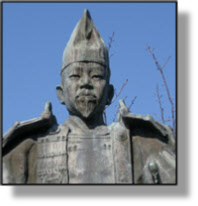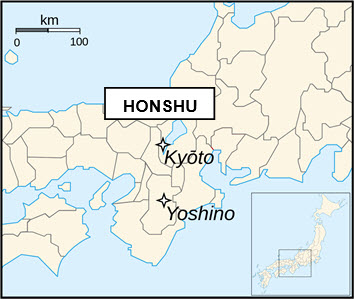


CIVIL WAR IN JAPAN 1336 -
RIVAL COURTS AT YOSHINO AND KYOTO
xxxxxAs we have seen, it was in 1192 (R1), following a long civil war, that the new leader, Yoritomo, founded a military government based on the shogunate system, a regime whereby feudal lords, supported by their Samurai warriors, governed the country. By 1333, however, these “shoguns” had become so powerful that imperial forces overthrew them and Emperor Daigo ruled from Kyoto. But not for long. In 1336 he was driven from power and sixty years of civil war broke out between the southern court at Yoshino and the northern court at Kyoto. As we shall see, peace was not restored until 1392 (R2).
 xxxxxAs we have seen, after a civil war which began in 1156 and dominated Japanese politics for virtually the whole of the reign of Henry II (1154-
xxxxxAs we have seen, after a civil war which began in 1156 and dominated Japanese politics for virtually the whole of the reign of Henry II (1154-
xxxxxBy 1333, however, these military strongmen had become so powerful that imperial forces, calling on local fighters, set out to overthrow them. This they achieved, and a shogunate government which had ruled for 140 years was brought to an end. The emperor Go-
achieved, and a shogunate government which had ruled for 140 years was brought to an end. The emperor Go-
Acknowledgements
Yoritomo: detail from statue at Genjiyama Park, Kamakura, about 50 kilometres south-
E3-


